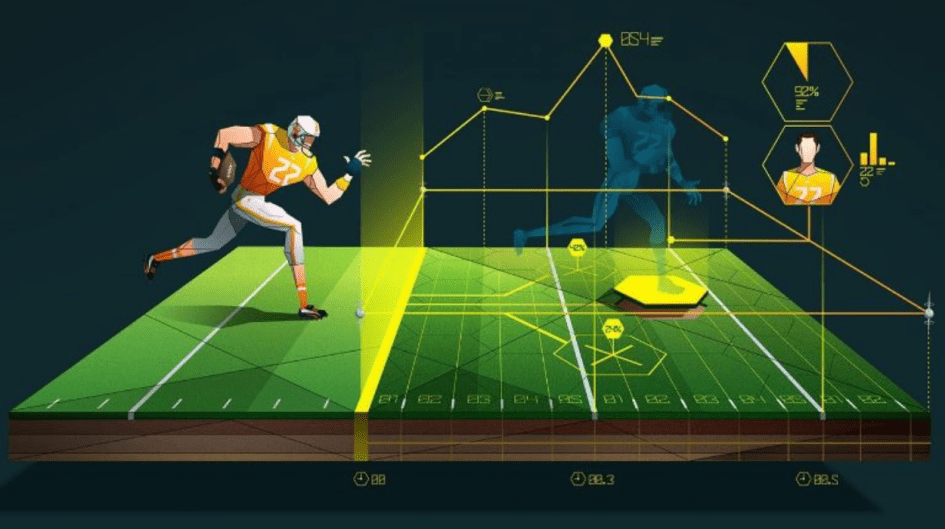Sports have quickly become one of the most popular forms of entertainment since their inception. With the advancement of technology and its application almost everywhere, the sports industry is no exception. Sports was one of the first industries to integrate technology into its analytics systems, which date back to the 1920s. However, cultural adoption began in the 1960s, when track and field adopted automated timing systems with photo-finish mechanisms.
Thanks to the integration of technology with sports, viewership rates have reached unprecedented heights, and one of the best examples would be the 2022 FIFA World Cup, which attracted 1.5 billion viewers worldwide.
Back in the day, a thorough account of the event was quickly drawn up after the trained analysts analyzed the match’s data, conducted both during and after the match. This data only gave information about what happened to the ball, not how the 22 players passed it around.
Have you ever questioned how the commentators were able to provide such a thorough analysis of the players’ strategies? Cameras around the field now record the movement of each player, thereby enabling the ML models to analyze the players’ gameplay and strategy.
Refereeing decisions have been one of the most controversial aspects of the sporting industry. Since the referee’s focus is solely on particular actions, their decisions may be subjective. The need for a more accurate and impartial refereeing system called for the introduction of an AI referee in many sports.
Video refereeing works as a piece of evidence for the referee and ultimately aids them in making the best decision concerning the game. In cricket, for example, the third umpire’s opinion is crucial for a match, and they are given several tools like the Decision Review System (DRS), which uses artificial intelligence to assist the on-field umpires.
In a violent sport like rugby, the players must collide and gather in a scrum. In such circumstances, it becomes difficult to distinguish between malicious behavior and innocent play. AI video analysis has assisted referees in making accurate calls.
In the sporting world, finding fresh talent with promise can be viewed as either an art or a science. This field requires highly skilled individuals with a hawk-eyed vision to bring in the best talent for the team. Even though human intelligence has significantly increased, it is impossible to pay attention to every minor detail.
As a result, extremely precise and effective AI and machine learning models are used to closely monitor how well the players perform when making predictions and assumptions. These models can provide in-depth information about more players than was previously possible because they can sort through data much faster than humans. Sports like basketball, baseball, and football are among the many that now use AI to give their professional teams top-notch coaching.
Sports in technology cannot be discussed without mentioning its application in generating revenue. Enthusiastic fans are a driving force behind the generation of revenue. In the past, placing a wager was as easy as picking your favorite team and putting your money there purely on instinct.
The state of the gambling industry appears to be changing with the development of AI. The AI models provide gamblers with large amounts of statistically supported data, assisting them in increasing their profits. Reinforcement Learning, one of the fundamental building blocks of AI models, is very helpful in producing optimal analysis by interacting with the vast amounts of data the models are trained with.
AI-powered betting platforms can provide better results with customized suggestions based on their users’ preferences, user histories, and individual risk profiles.
Gambling and fraud do not exclude each other. However, since machine learning models can identify suspicious activity thanks to the massive amounts of data they’ve been trained on, they’re actively reducing fraud.
The application of AI in sports and gambling has benefits, but it also has drawbacks. If the data is flawed or lacking, heavily relying on it could produce inaccurate results. AI’s decision-making raises questions about accountability and trust because it lacks transparency and human intellect. By understanding AI’s biases and limitations, users can interpret predictions more responsibly, promoting healthier gambling practices.
The incorporation of AI into sports and gambling represents a paradigm shift in how these industries operate. AI is changing the way we interact with sports and gambling, from bettering analysis and talent scouting to improving betting recommendations and reducing fraud. By embracing AI responsibly and addressing its limitations, we can ensure a future in which technology and human intelligence collaborate to create a thrilling and fair sporting experience.



Leave a Reply